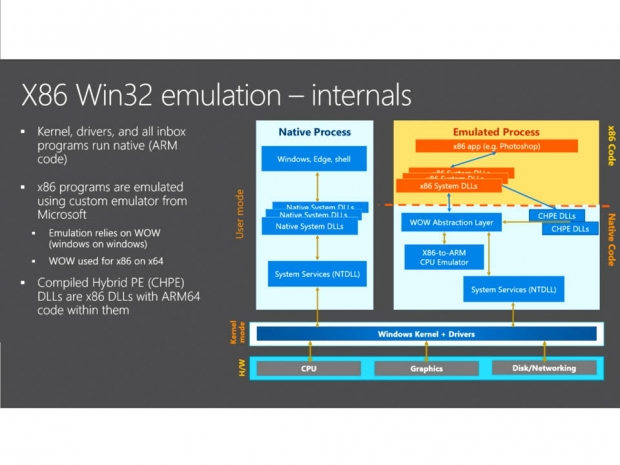In November, Microsoft formally announced that it would be partnering with Qualcomm to bring Snapdragon 835-powered Windows 10 devices to the market. At every opportunity given, Qualcomm has since demonstrated its ability to run buttery smooth OEM PCs based on its own chips that are fully capable of emulating commonplace Win32 programs. But this is where the line gets drawn for Intel, who like a true American settler has read the Code of the West and perceives its x86 intellectual property as coming under siege by an eager outsider.
Rather than agreeing to an exchange of technologies, as Intel and AMD did back in 1976 through a cross-license agreement, Qualcomm and Microsoft appear set on monetization through emulation, a strategy that may work exceptionally well in certain PC market segments, but falter in others. At the bottom line, Intel is upset because an entire handful of vendors, including Lenovo, HP, and ASUS, have all committed to bringing Qualcomm-powered Windows 10 notebooks and 2-in-1 convertibles to market in 2017. The advantages of running these machines on ARM chips, rather than Intel Atom/Pentium/Core M/Core series processors, include significant battery life advantages, Gigabit Class LTE and fanless designs that could further blur the boundaries between horsepower and ergonomics for the entire mobile PC marketplace.
As such, Intel published a blog post on Thursday titled, “X86: Approaching 40 And Still Going Strong” by the company’s Executive VP and also its Director of Systems and Software Research. But rather than citing its longstanding x86 cross-license AMD partnership, Intel plants a more direct barbed-wire fence by mentioning a company called Transmeta, which tried a similar x86 move in the early 2000s (“Crusoe” and “Efficeon”) using "code morphing" (emulation) techniques. Intel says it enforced patents relating to its own SIMD instruction sets. What the authors do not mention is Intel’s infringement of ten Transmeta patents and the ensuing $120 million upfront settlement. Of course, Transmeta agreed to assign a small percentage of its patents to Intel as part of the deal, though the company unfortunately disappeared in July 2009 following the economic recession and after a series of financial setbacks.
Qualcomm’s x86 emulation is not Intel’s biggest concern
It is important to note that Snapdragon 835 chips with Win32 app emulation will likely only arrive on 2-in-1 convertible devices and entry-level desktops below a certain price threshold. As far as we can tell, Qualcomm has not announced any intentions to bring its ARM-based SoCs to the premium 2-in-1 notebook and desktop market, which includes anything with a price tag above $699. The company’s first competitor, Apple, last week announced two new iPad Pros at $649 (10.5-inches) and $799 (12.9-inches), respectively. These devices both approach and exceed the aforementioned threshold, but do not stray far from it. Of course, Apple pays an undisclosed fee to ARM to use its intellectual property, but goes on to develop its own A-series chips in-house.
Qualcomm’s second competitor is Google, which has seen Chromebook sales surge from just 2.9 million units in 2013 to an estimated 14.2 million units in 2017. These are entry-level devices with a usual range anywhere between $129 and $399, depending on screen quality and the inclusion of an ARM or x86-based processor.
Intel’s focus should be on retaining innovation cycle without cutting corners
So with Apple and Google in primary focus for Qualcomm’s Snapdragon competition, that should leave Intel with little to worry about in regards seizing its clutch on the mobile PC innovation cycle. The top selling Intel-based 2-in-1 convertible notebooks right now include the Microsoft Surface Book (Core i5/i7), HP Spectre x360 (Core i5/i7), HP Elite x2 (Core m3/m5), Samsung Notebook 7 Spin (Core i7), ASUS ZenBook Flip UX360 (Core m3), Dell Inspiron 7000 (Core i5/i7), and the Lenovo Yoga series (Core m5/m7/i5/i7), all of which are priced at $699 and above. Intel just needs to realize its premium place in the 2-in-1 mobile PC market, and it can continue to lead by deliver new processor generations that do not cut corners on the traditional 18-month innovation cycle for the sake of increasing profit margins.
“Only time will tell if new attempts to emulate Intel’s x86 ISA will meet a different fate,” says the blog post in closing. “Intel welcomes lawful competition... However, we do not welcome unlawful infringement of our patents, and we fully expect other companies to continue to respect Intel’s intellectual property rights.”
Qualcomm spokesperson set us following statement:
"Given our recent announcement with ASUS, HP and Lenovo, we found the blog that one of our competitors published on June 8 very interesting. We look forward to the launch of the always connected Windows 10 PC powered by the Qualcomm Snapdragon 835 Mobile PC Platform later this year. As showcased at Computex 2017 in conjunction with Microsoft, the Snapdragon 835 Mobile PC Platform brings a true always connected PC experience with support for up to Gigabit LTE connectivity and all-day battery life for sleek, thin and fanless designs. This will change the future of personal computing."




